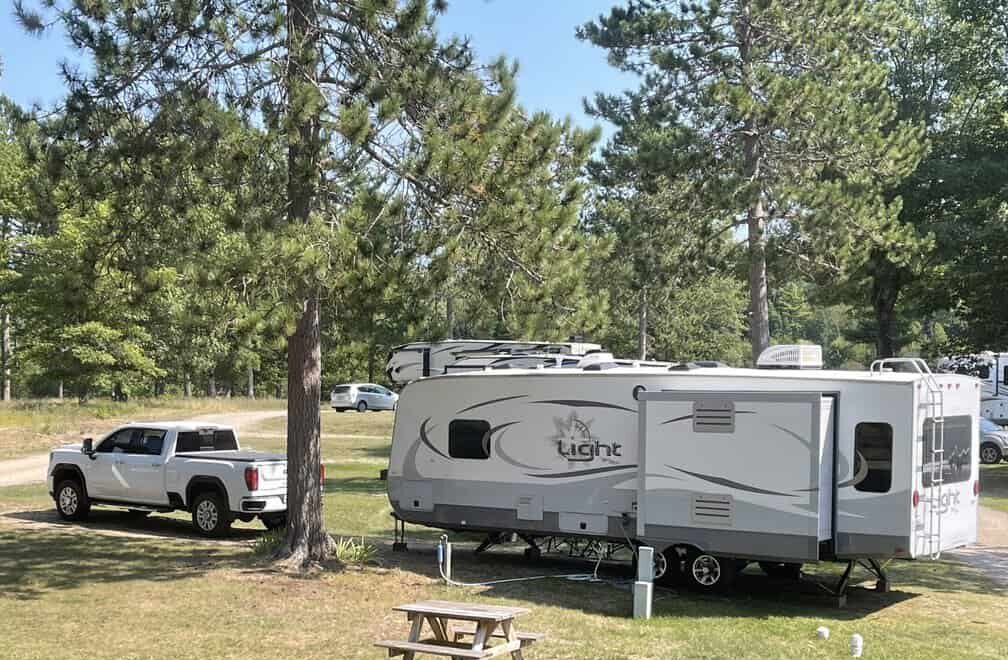
Seatbelts are found in almost all vehicles that carry people back and forth from their destinations. Lots of people wonder about seatbelts in RVs. I got curious too, so I did some research. Here’s what I found.
Why don’t RVs have seatbelts? RVs actually do have seatbelts. All RVs that are designed to have people riding in them have seatbelts. Class A and Class B and Class C motorhomes have seatbelts. Fifth wheels and trailers don’t because they shouldn’t have people riding in them while on the road.
Safety should always be one of your top priorities, whatever vehicle you may be taking on your travels. Without seatbelts, your chance of being killed if you get into an accident raise substantially. It is best to wear a seatbelt at all times.
How Seatbelts Work
Before you understand why it’s so important to wear seatbelts in RVs, you might want to know how seatbelts work.
In a typical seatbelt system, the belt webbing is connected to a retractor mechanism. The central element in the retractor is a spool, which is attached to one end of the webbing.
Inside the retractor, a spring applies a rotation force, or torque, to the spool. This works to rotate the spool so it winds up any loose webbing.
When you pull the webbing out, the spool rotates counter-clockwise, which turns the attached spring in the same direction. Effectively, the rotating spool works to untwist the spring. The spring wants to return to its original shape, so it resists this twisting motion.
If you release the webbing, the spring will tighten up, rotating the spool clockwise until there is no
The retractor has a locking mechanism that stops the spool from rotating when the car is involved in a collision. There are two sorts of locking systems in common use today:
- systems triggered by the car’s movement
- systems triggered by the belt’s movement
First System
The first sort of system locks the spool when the car rapidly decelerates (when it hits something, for example).
The central operating element in this mechanism is a weighted pendulum. When the car comes to a sudden stop, the inertia causes the pendulum to swing forward. The pawl on the other end of the pendulum catches hold of a toothed ratchet gear attached to the spool.
With the pawl gripping one of its teeth, the gear can’t rotate counter-clockwise, and neither can the connected spool. When the webbing loosens again after the crash, the gear rotates clockwise and the pawl disengages.
Second System
The second kind of system locks the spool when something jerks the belt webbing. The activating force in most designs is the speed of the spool rotation. The diagram shows a common configuration.
The central operating element in this design is a centrifugal clutch — a weighted pivoting lever mounted to the rotating spool. When the spool spins slowly, the lever doesn’t pivot at all.
A spring keeps it in position. But when something yanks the webbing, spinning the spool more quickly, centrifugal force drives the weighted end of the lever outward.
The extended lever pushes a cam piece mounted to the retractor housing. The cam is connected to a pivoting pawl by a sliding pin. As the cam shifts to the left, the pin moves along a groove in the pawl.
This pulls the pawl into the spinning ratchet gear attached to the spool. The pawl locks into the gear’s teeth, preventing counter-clockwise rotation.
In some newer seatbelt systems, a pretensioner also works to tighten the belt webbing. In the next section, we’ll see how these devices work.
In layman’s terms, both systems keep your body from flying around the coach or through the windshield in the event of a forceful impact.
Class A Vehicles
Now that you understand the mechanics of the thing, it’s much easier to understand why they are important, and why they are placed in RVs. (To better your chances of living.)
Class A RVs are the largest type and look similar to buses. They are between 15,000 and 30,000 pounds and often have living areas that extend out when parked. This slide-out portion is part of the reason the RV Consumer Group (RVCG) say the Class A RVs have more structural problems.
The RVCG believes that close to 50% of Class As will not sustain a collision at 20 miles per hour without serious damage. There is no rear occupant crash testing required for Class A RVs.
A false sense of security is common when driving a Class A RV, because of its size. Some people assume that because it is larger, it will be better off in a crash.
But bigger is not necessarily safer with RVs. For instance, the structural soundness of an RV may be questionable in a crash because of design features like galley slide-outs.
Often the rear compartment is built on a wood or aluminum frame and could be crushed in an impact or rollover.
Also in Class A RVs, while the front seat belts need to meet federal standards, the front compartment itself does not have to meet any crash standards and may not be crash tested.
Class B Vehicles
Class B is more like a built-out conventional van. They typically weigh between 6,000 and 8,000 pounds so they have to meet federal seat belt standards (FMVSS 208)for the front but not for the rear seat occupants.
Class B RVs can require lap belt only seat belts in the back seating if it carries a chassis-mount camper that
Lap belts are not often seen as safe. They were common for many years until evidence of the potential of lap belts to cause separation of the lumbar vertebrae and the sometimes associated paralysis, or “seat belt syndrome,” led to progressive revision of passenger safety regulations in nearly all developed countries to require three-point belts first in all outboard seating positions and eventually in all seating positions in passenger vehicles.
Class C Vehicles
Class C RVs are more like a moving truck. These weigh between 10,000 and 12,000 pounds and are built on a van or truck chassis. But they come with the front cab from the vehicle manufacturer so the cab still has those safety features.
Class C also have to meet federal seat belt standards for the front seating positions but not the rear.
Naturally, it is not a brilliant idea to haul people for any length of time in the back of a moving van. In the event of a crash, those in the driver’s and passenger’s seat may be alright, but the people in the back have undoubtedly spent a good deal of time airborne, before slamming into the wall, roof, or floor.
They will inevitably sustain several severe internal and external injuries, that may be fatal.
So don’t do it. No matter how much someone tries to convince you to let them ride in the back of your moving van. Perhaps share with them the considerable amount of displeasure that comes with slamming spread-eagle into the wall at 70 miles an hour.
Laws by State
The laws regarding seatbelts in RVs vary by state. They are split into two categories: Front Seat, and All. The Front Seat states only require seatbelts to be worn by those in the front seats of the car.
The other states, as you may have guessed, require that all passengers anywhere in the RV must be restrained. Below are two lists for your reference.
Front Seat States
- Alabama
- Arkansas
- Connecticut
- Florida
- Hawaii
- Illinois
- Indiana
- Kansas
- Louisiana
- Maryland
- Michigan
- Minnesota
- Mississippi
- Missouri
- Nebraska
- New Jersey
- New York
- North Carolina
- North Dakota
- Ohio
- Oklahoma
- Pennsylvania
- South Dakota
- Tennessee
- Texas
- Virginia
- West Virginia
- Wisconsin
All Seat States
- Alaska
- California
- Colorado
- Delaware
- Washington
- D.C.
- Georgia
- Idaho
- Iowa
- Kentucky
- Maine
- Massachusetts
- Montana
- New Hampshire
- New Mexico
- Oregon
- Rhode Island
- South Carolina
- Utah
- Vermont
- Washington
- Wyoming
By Age Laws
There are seatbelt laws for minors as well. The following states require that children of the ages below be properly restrained:
- Arizona: 5 to 15
- Connecticut: 4 to 16
- Florida: 6 to 17
- Hawaii: 4 to 17
- Georgia: 6 to 17
- Illinois: 8 to 15
- Indiana: 4 to 11
- Kansas: 4 to 14
- Louisiana: 6 to 15
- Michigan: 4 to 15
- Minnesota: 4 to 10
- Mississippi: 4 to 10
- Missouri: 4 to 15
- Nebraska: 4 to 18
- New Jersey: 8 to 17
- New York: under 15
- North Carolina: under 15
- North Dakota: 7 to 17
- Oklahoma: 6 to 12
- Pennsylvania: 8 to 17
- South Dakota: under 18
- Tennessee: under 16
- Texas: under 17
- Virginia: under 16
- West Virginia: under 17
- Wisconsin: 4 to 15
The two states that do not have age-based seatbelt requirements, apart from the All Seats States, are Ohio and Arkansas.
Related Questions
Can I put a car seat in an RV? It is absolutely an excellent idea to put a car seat in an RV, as long as you secure it properly and securely. If a car seat is restrained in the rear compartment, a big risk is the wooden seat structure it’s belted to and cabinets can come apart during a crash, increasing the risk of injury or death.
Then these structures (and kitchen equipment, and mounted TVs, and decorations) become projectiles. There is a serious injury risk to all the passengers.
Can I install seatbelts into my RV myself? It is possible to install seatbelts yourself if you don’t like the ones provided, or if there aren’t enough in the vehicle. Just be sure to purchase the correct one, and install it properly. Get professional assistance if needed.



